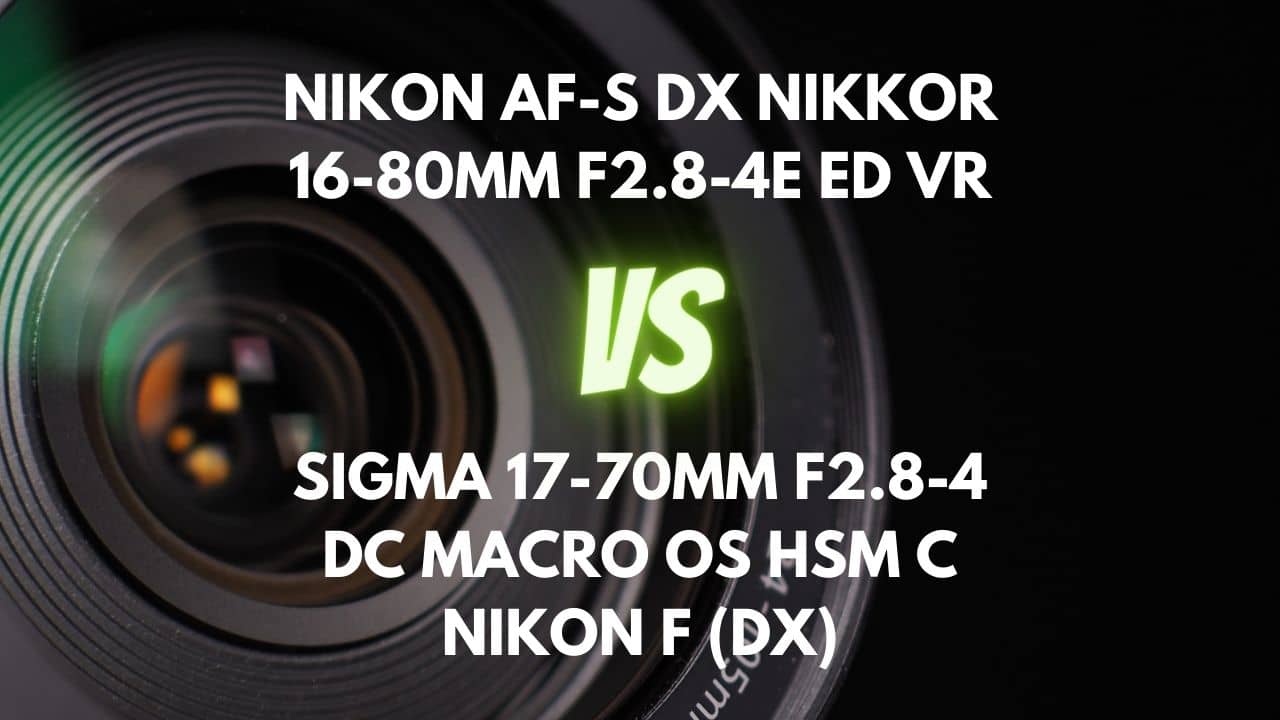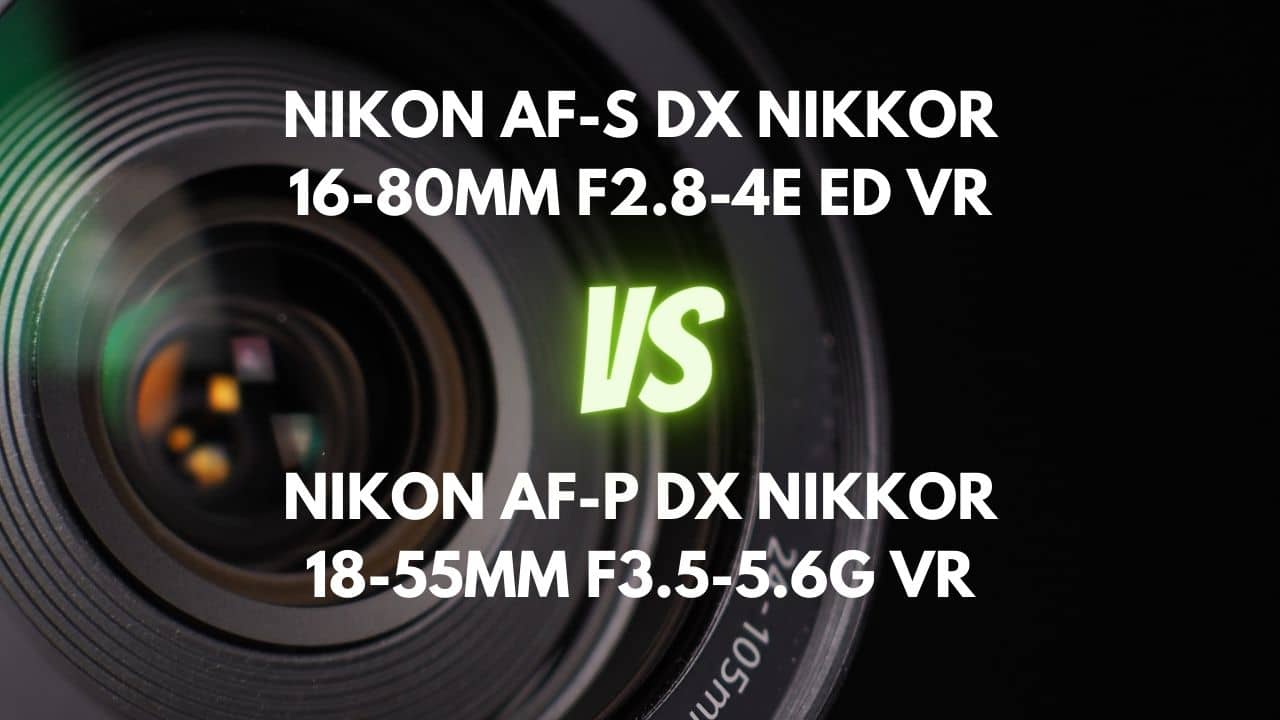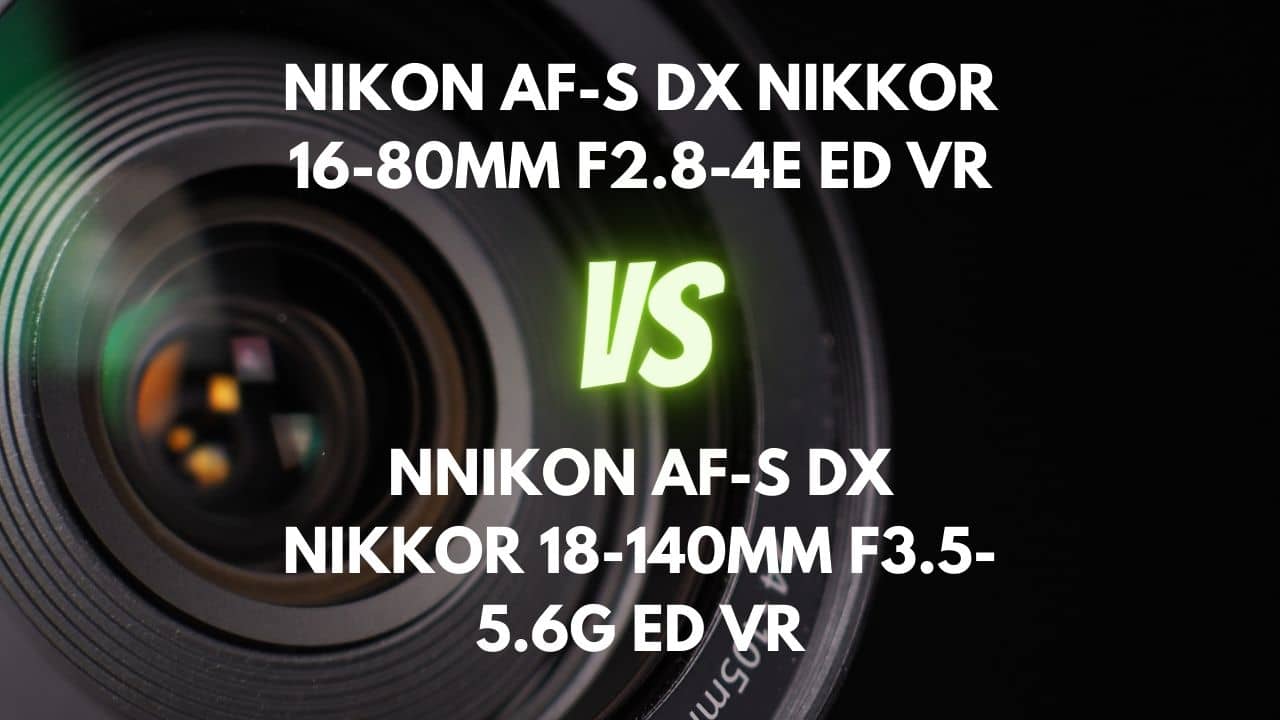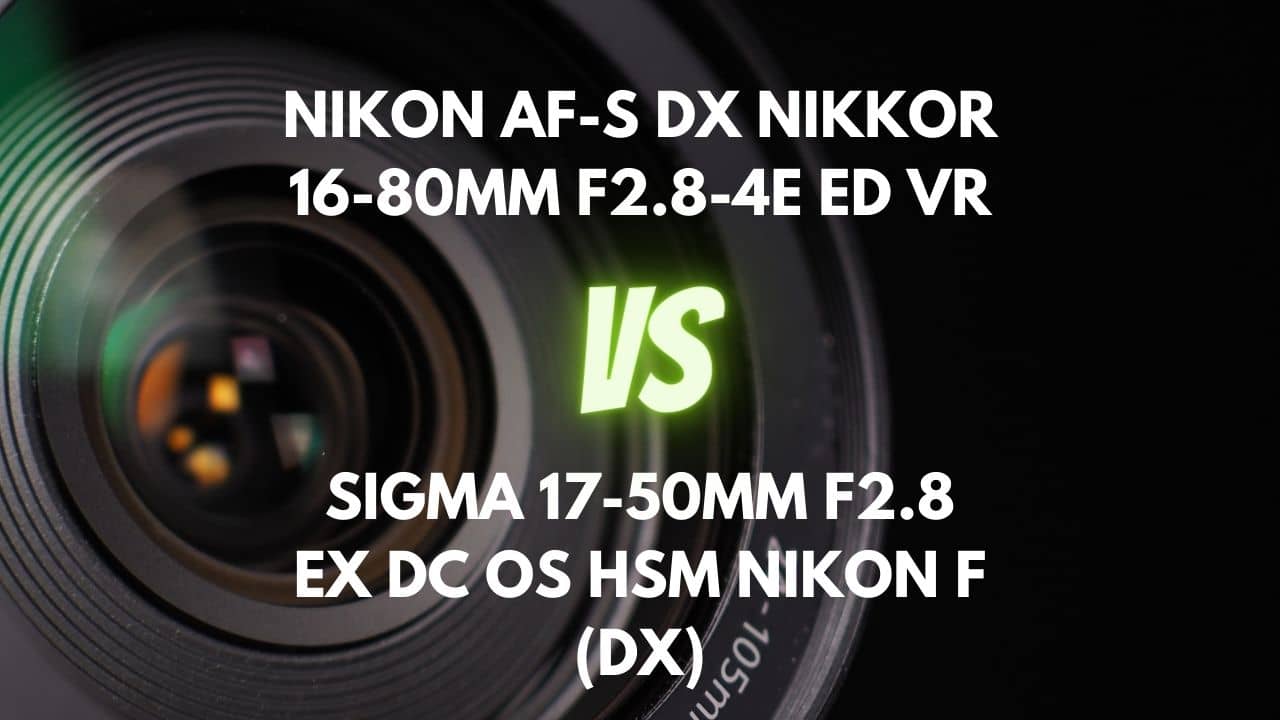Are you a photography enthusiast caught between the versatile Nikon DX 16-80mm f/2.8-4 and the alluring Nikon DX 18-105mm f/3.5-5.6? You’re not alone.
The quest for the perfect lens that meets our unique photography needs can be a daunting challenge. As the world of photography grows more diverse and dynamic, these two lenses have emerged as popular options for photographers seeking to capture stunning images in various settings.
Whether you’re an adventurous landscape photographer, an ambitious event shooter, or a passionate wildlife explorer, understanding the differences between these two powerful lenses can make all the difference in your creative journey.
In this article, we’ll take a deep dive into the intriguing world of the 16-80mm and 18-105mm lenses, exploring their distinct strengths, weaknesses, and ideal use cases. From their low light performance to their sharpness and bokeh qualities, we’ll provide a comprehensive comparison to help you make an informed decision.
So, buckle up and join us as we unravel the mysteries of these two remarkable lenses and discover which one will truly resonate with your photography aspirations.
Your next masterpiece awaits!
Overview
| Nikon AF-S DX NIKKOR 16-80mm F2.8-4E ED VR | Nikon AF-S DX NIKKOR 18-105mm F3.5-5.6G ED VR | |
|---|---|---|
| Max Aperture | F2.8-4.0 | F3.5-5.6 |
| Aperture Type | Variable | Variable |
| Focal Range (mm) | 16-80 | 18-105 |
| Mount Type | Nikon F (DX) | Nikon F (DX) |
| Zoom Ratio (X) | 5 | 5.8 |
With its maximum aperture ranging from f/2.8-4.0, the Nikon DX 16-80mm offers superior low-light capabilities and a more shallow depth of field compared to the Nikon DX 18-105mm f/3.5-5.6, which has a maximum aperture of f/3.5-5.6.
As they feature a variable aperture, the maximum aperture of both lenses changes as you zoom in or out. In terms of focal range, both lenses are suitable for landscape, architecture, street, travel photography.
The 16-80mm lens has a slightly wider field of view at its shortest focal length, which is beneficial for capturing more of a scene in landscape, architecture, interior photography and environmental portrait photography. The 18-105mm lens offers more reach at its longest focal length, providing more magnification for subjects that are farther away, such as in sports, wildlife, or event photography.
Both lenses are designed for Nikon F (DX) mount cameras and have comparable zoom ratios, with the 16-80mm lens featuring a 5.0x zoom ratio and the 18-105mm lens having a slightly higher 5.8x zoom ratio. The 18-105mm lens may be a better choice for those who require a longer focal length, while the 16-80mm lens is better for those who need a wider angle.
When considering low light performance, the 16-80mm lens has an advantage due to its wider maximum aperture, which allows more light to enter the camera, resulting in cleaner, sharper images.
Design and Ease of Use
| Nikon AF-S DX NIKKOR 16-80mm F2.8-4E ED VR | Nikon AF-S DX NIKKOR 18-105mm F3.5-5.6G ED VR | |
|---|---|---|
| Diameter x Length (mm) | ⌀80×85.5mm | ⌀76×89mm |
| Weight (gr) | 480 | 420 |
| Filter Thread (mm) | 72 | 67 |
| Weather Sealing | No | No |
| Zoom Method | Rotary (internal) | Rotary (extending) |
| Distance Scale | Yes | No |
| DoF Scale | No | No |
| Hood Supplied | Yes | Yes |
| Hood Code | HB-75 | HB-32 |
Comparing the Nikon DX 16-80mm f/2.8-4 and Nikon DX 18-105mm f/3.5-5.6, we can see some differences in their specifications.
The 16-80mm lens has a slightly larger diameter (⌀80mm) and shorter length (85.5mm) compared to the 18-105mm lens (⌀76mm x 89mm). This makes the 16-80mm lens a bit bulkier, which could impact portability and storage.
However, the 18-105mm lens is lighter, weighing 420 grams compared to the 16-80mm lens’s 480 grams. The lighter weight could make it easier to carry around, swap lenses quickly, and provide better balance when handling the camera.
The 16-80mm lens features an internal rotary zoom method, meaning it doesn’t change its physical size when zooming. This design is typically easier to weather-seal and offers consistent balance during shooting. However, the complexity of the internal zoom may result in a higher price and potentially more parts that could malfunction.
On the other hand, the 18-105mm lens uses an extending rotary zoom method. While this design tends to be simpler and possibly more durable, the lens physically extends when zooming, which can make it more cumbersome to handle, and might be more difficult to weather-seal.
In conclusion, both lenses have their strengths and weaknesses. The 16-80mm lens offers better weather sealing and consistent balance due to its internal rotary zoom method, but it’s heavier and bulkier. The 18-105mm lens is lighter and potentially more durable, but its extending rotary zoom method can make it more challenging to handle and weather-seal.
Ultimately, the superior lens depends on your preferences and shooting needs. If you prioritize weather sealing and consistent balance, the 16-80mm lens may be the better choice. However, if you prefer a lighter, simpler lens that is potentially more durable, the 18-105mm lens could be the better option.
Lens Mount and Barrel
Comparing the Nikon DX 16-80mm f/2.8-4 and Nikon DX 18-105mm f/3.5-5.6, we can observe differences in their lens mount and barrel materials.
The 16-80mm lens features a sturdy metal lens mount with a rubber seal for added protection against dust, while the 18-105mm lens has a hard plastic lens mount without a rubber gasket, indicating it is not weather-sealed. Metal lens mounts are typically more durable and can withstand repeated use, whereas plastic mounts are less expensive but prone to wear and tear.
The lens barrel of the 16-80mm lens is made of plastic with rubberized rings for focus and zoom, providing a comfortable grip. Its internal zoom mechanism ensures that the lens doesn’t change its physical size when zooming in or out.
In contrast, the 18-105mm lens comes with a top-notch industrial polycarbonate lens barrel that boasts a textured finish, perfectly matching the aesthetic of Nikon camera bodies. However, its non-internal zoom action causes the lens to extend almost 2 extra inches at the 105mm end. Plastic lens barrels are generally lighter and more budget-friendly, but not as durable as metal barrels.
In conclusion, both lenses have their strengths and weaknesses in terms of lens mount and barrel. The 16-80mm lens offers a more durable metal mount and a comfortable grip, as well as an internal zoom mechanism for consistent size.
Meanwhile, the 18-105mm lens features a lighter, more affordable plastic mount and barrel but lacks weather sealing and has a non-internal zoom action.
If you prioritize durability and a professional feel, the 16-80mm lens may be the better choice. However, if you value portability and affordability, the 18-105mm lens could be the more suitable option.
Weather Sealing
Comparing the Nikon DX 16-80mm f/2.8-4 and Nikon DX 18-105mm f/3.5-5.6 in terms of weather sealing, we can see that the 16-80mm lens, while not fully weather-sealed, does have a rubber gasket around the lens mount to keep dust out of the camera body. Additionally, its front element features a fluorine coating that repels water and makes it easier to clean.
However, the 18-105mm lens does not offer any weather-sealing, as it lacks internal seals at the rings and switches, a gasket at the lens mount, a fluorine coating on the front element, or any other protective measures.
Weather sealing provides valuable protection for lenses, particularly when shooting in outdoor or unpredictable environments. It enhances durability, performance, and longevity of the lenses by shielding them from dust, moisture, and light water splashes. While not essential for portrait lenses, weather sealing can still be an important feature for photographers who frequently shoot in various conditions.
In conclusion, the 16-80mm lens has superior weather sealing compared to the 18-105mm lens, offering better protection against dust and moisture. Although not fully weather-sealed, the 16-80mm lens has features that increase its resilience in different shooting conditions, such as the rubber gasket and fluorine coating.
If you often shoot outdoors or in unpredictable weather, the 16-80mm lens’s weather sealing will provide valuable protection and peace of mind, making it the better choice in this regard. If your photography is mostly confined to indoor or controlled environments, weather sealing may not be a crucial factor, and you should consider other aspects while making a choice between the two lenses.
Rings
The Nikon DX 16-80mm f/2.8-4 features a large, rubberized zoom ring at the front and a narrow manual focusing ring at the rear. Its zoom ring has a slightly heavy movement, while the manual focusing ring has a grinding feel and takes a third of a turn from infinity to the minimum focus distance. The lens also includes a modest focus-distance-scale window marked in both feet and meters between the two rings.
Conversely, the Nikon DX 18-105mm f/3.5-5.6 features a broad, ribbed, rubber-textured zoom ring placed towards the front of the barrel, while a thin focus ring with a ridged rubber coating is located behind it. The zoom ring has a pleasing resistance and travels approximately 80 degrees, while the focus ring provides about 100 degrees of travel, which may not be optimal for precise manual focus control. Unfortunately, this lens lacks a windowed distance scale or depth-of-field indicator, and there is no zoom lock mechanism.
When evaluating the rings in terms of many factors, the 16-80mm lens outperform the 18-105mm lens in some aspects. While the 18-105mm lens has smoother ring movements and better resistance, the 16-80mm lens offers a focus-distance-scale window, a more sturdy and well-built zoom ring, and better ergonomics due to the rubberized texture.
Switches/Buttons
The Nikon DX 16-80mm f/2.8-4 features 3 switches/buttons on the barrel, including an AF/MF switch for manual override of autofocus, an IS switch to toggle the 4-stop vibration reduction system, and a third switch to choose between Normal and Active VR modes. These switches are clearly labeled but are all identical, which may make it challenging to change settings quickly while the camera is raised to your eye.
In contrast, the Nikon DX 18-105mm f/3.5-5.6 has just two control switches on its left side – one for toggling autofocus between A and M modes and the other for switching vibration reduction on or off. The lens lacks any other switches or buttons for additional controls.
When comparing the two lenses in terms of switches and buttons, the 16-80mm lens offers more options and controls, allowing photographers to fine-tune their settings and adapt to different shooting conditions. However, the identical design of the switches may require extra time to identify and adjust the desired settings while shooting.
In contrast, the 18-105mm lens has fewer switches, resulting in a simpler and more streamlined design. While this may be more user-friendly for some photographers, it lacks the additional control and customization options available on the 16-80mm lens.
In conclusion, the 16-80mm lens has a superior design in terms of switches and buttons, offering more control and customization options to photographers. However, the 18-105mm lens provides a simpler and more streamlined design that may be more user-friendly for some photographers.
Filter Thread
The Nikon DX 16-80mm f/2.8-4 has a 72mm plastic filter thread, and the front element does not rotate when focusing. This makes it easy to use with filters, such as polarizing or ND grad filters, without worrying about them spinning around. However, it’s not compatible with larger 77mm filters, which are more common and widely available.
On the other hand, the Nikon DX 18-105mm f/3.5-5.6 features a 67mm plastic filter thread. The filter thread also does not rotate during focus or zooming, ensuring compatibility with polarizers and ND graduated filters. The smaller size of the 18-105mm lens filter thread may result in more affordable filter options, but it may not be as versatile as the 77mm filters used on other lenses.
Both lenses feature a plastic filter thread, which is lightweight and less expensive than metal alternatives. Plastic filter threads are more forgiving when the lens is dropped, as they can bounce back without staying bent. Nevertheless, they are prone to wear and tear with frequent mounting and dismounting of lens filters, which could potentially affect their durability.
In conclusion, the 18-105mm lens with its 67mm filter thread offers a more affordable and accessible option for photographers looking to invest in filters. However, the 16-80mm lens with its 72mm filter thread provides a slightly larger size, which may be beneficial for those seeking a balance between compatibility and versatility.
Lens Hood
The Nikon DX 16-80mm f/2.8-4 comes with a squared petal-style lens hood, which is a unique departure from more traditional designs. Made of hard plastic with a matte finish, the ergonomic bevel ensures a comfortable grip when attaching or detaching the hood. An innovative lock button enables smooth rotation and secure attachment, providing an advantage over older twist-on/click hoods that tend to wear out over time.
On the other hand, the Nikon DX 18-105mm f/3.5-5.6 includes a petal-shaped plastic lens hood that attaches via a bayonet mount. Although the inside of the lens hood is not flocked, it performs well in blocking sunlight that enters at oblique angles, thus effectively shielding the front element of the lens. The lens hood adds an additional 1.25 inches to the lens’s overall length, and it can be reversed for easy storage.
Comparing the two lens hoods, the 16-80mm lens hood stands out with its distinct squared petal-style design and lock button feature, offering a smooth and secure attachment experience. The 18-105mm lens hood is more traditional, with a bayonet mount for easy attachment and reversal for storage. Both lens hoods provide good protection against unwanted light, but the 16-80mm lens hood offers a more innovative design and improved user experience.
Focusing and Optical Stabilization
| Nikon AF-S DX NIKKOR 16-80mm F2.8-4E ED VR | Nikon AF-S DX NIKKOR 18-105mm F3.5-5.6G ED VR | |
|---|---|---|
| Autofocus | Yes | Yes |
| AF Motor | Silent Wave Motor | Silent Wave Motor |
| Rotating Front Element | Does not rotate on focusing | Does not rotate on focusing |
| Min Focus Distance | 0.35m | 0.45m |
| Max Magnification (X) | 0.22 | 0.2 |
| Full-Time Manual Focus | Yes | Yes |
| Focus Method | Internal | Internal |
Focusing Performance
The Nikon DX 16-80mm f/2.8-4 boasts impressive autofocus performance, providing quick, accurate, and relatively quiet focusing. This makes it suitable for both photography and video applications. In low-light situations, the lens maintains its autofocus accuracy and speed, and the initial autofocus acquisition is commendable.
The lens supports manual focus override, allowing photographers to fine-tune focus even when autofocus is engaged. The internally focusing design ensures a constant length regardless of focus and zoom settings, and minimal focus breathing makes it an excellent choice for videographers and photographers requiring consistent framing.
In contrast, the Nikon DX 18-105mm f/3.5-5.6 is equipped with a Silent Wave Motor drive that provides fast and virtually silent autofocus operation. While it may not be as swift as some of the higher-end AF-S lenses, it still performs accurately and reasonably quickly. Moreover, you can override autofocus by simply turning the focus ring at any time, and the manual focus action is smooth and user-friendly. That being said, autofocus performance may suffer in low-light conditions, particularly at the longer end of the zoom range.
In conclusion, the 16-80mm lens outperforms the 18-105mm lens in terms of focusing performance. Its quick and accurate autofocus, low-light capabilities, and minimal focus breathing make it an excellent choice for a variety of shooting situations. While the 18-105mm lens offers reliable autofocus performance and virtually silent operation, it falls short in low-light situations compared to the 16-80mm lens. Overall, the 16-80mm lens delivers superior focusing performance, making it the better choice for photographers and videographers in various scenarios.
Optical Stabilization
The Nikon DX 16-80mm f/2.8-4 features a Vibration Reduction (VR) system with 4 stops of compensation, allowing for sharp images at slower shutter speeds. It has two modes: Normal and Active, with Active being more suited for shooting from a moving platform. With the VR enabled, sharp shots can be achieved at 1/3 of a second at 16mm and 1/4 of a second at 80mm, even with some hand movement. However, stabilization performance may vary based on individual shooting conditions and photographer steadiness.
In contrast, Nikon DX 18-105mm f/3.5-5.6 has Nikon’s Vibration Reduction (VR) image stabilization system, which provides up to 3 stops of stabilization. This system only has one stabilization mode and doesn’t have a VR Active mode like some higher-grade VR lenses. The VR system can be toggled via a switch on the lens barrel and is very quiet. When using the lens at 50mm, it is possible to achieve sharp handheld images at shutter speeds as slow as 1/8 second, while at 70mm, you can expect sharp results at 1/13 second or higher shutter speeds.
Optical stabilization is not always essential for wide-angle photography but can be beneficial in certain situations, such as low-light conditions, handheld shooting, or when recording video. Both lenses offer optical stabilization, but the 16-80mm lens provides better performance with 4 stops of compensation compared to the 18-105mm lens, which only provides up to 3 stops.
In conclusion, the 16-80mm lens has a superior optical stabilization system with 4 stops of compensation and two stabilization modes, making it the better choice for photographers who prioritize stability and sharpness in various shooting conditions.
Image Quality
| Nikon AF-S DX NIKKOR 16-80mm F2.8-4E ED VR | Nikon AF-S DX NIKKOR 18-105mm F3.5-5.6G ED VR | |
|---|---|---|
| Special Elements | 4 ED and 3 aspherical elements. Nano Crystal Coat. | ED glass element and aspherical lens element |
| Diaphragm Blades | 7 | 7 |
| Circular Aperture | Yes | Yes |
Aberration
The Nikon DX 16-80mm f/2.8-4 demonstrates good control of chromatic aberration, with only noticeable fringing at 16mm, which can be easily corrected in-camera or during post-processing. Spherochromatism, a more advanced form of chromatic aberration, is absent in this lens. Coma is also well-managed, with just a tiny bit visible under certain settings that disappear as the lens is stopped down. However, spherical aberration is present at the extreme end of the lens’s focusing distance, leading to some loss of contrast and requiring post-processing for high-impact images.
Conversely, the Nikon DX 18-105mm f/3.5-5.6 may exhibit some chromatic aberration, particularly at its widest focal length of 18mm, but the degree of distortion is generally tolerable unless producing very large prints. Throughout all focal lengths, chromatic aberration is generally well-controlled, and the choice of aperture has minimal effect on its occurrence. When used at wide apertures, slight chromatic aberration and light fall-off may be visible at the borders, but the image quality becomes significantly sharper in the f/5.6-f/11 range.
In conclusion, the 16-80mm lens showcases better aberration control compared to the 18-105mm lens. With minimal chromatic aberration, controlled coma, and no spherochromatism, the 16-80mm lens offers superior image quality, despite the presence of spherical aberration at the extreme focusing distance. While the 18-105mm lens performs decently in controlling chromatic aberration, it falls short when compared to the 16-80mm lens.
Sharpness
The Nikon DX 16-80mm f/2.8-4 boasts impressive sharpness at most zoom settings, with particularly good center sharpness. However, corner sharpness may suffer at wider focal lengths and wide open apertures, but it can be significantly improved by stopping down to around f/5.6-8. The sharpest aperture fluctuates slightly based on the focal length but is generally found within the f/5.6-8 range.
In contrast, the Nikon DX 18-105mm f/3.5-5.6 demonstrates consistent sharpness performance throughout the entire zoom range, exhibiting excellent performance at all focal lengths. While shooting at wide-open apertures may cause some chromatic aberration and light fall-off, image sharpness is likely to increase significantly when the lens is stopped down, with the sharpest results typically achieved around f/11. At f/16, the edges remain very sharp, and even at f/22, sharpness surpasses that of wide open apertures. In certain cases, corner softness may be visible, but this can usually be resolved by stopping down the lens. For the most part, the level of sharpness is suitable for producing prints, with the exception being when the lens is stopped down beyond f/16 at 105mm.
In summary, both lenses deliver commendable sharpness, with the 16-80mm lens having a slight advantage in center sharpness, while the 18-105mm lens offers more consistent performance throughout its zoom range. If center sharpness is a priority, the 16-80mm lens would be the better choice. However, if consistency across various focal lengths is more important, the 18-105mm lens might be the superior option.
Bokeh Quality
The Nikon DX 16-80mm f/2.8-4 produces bokeh of varying quality, depending on the settings used. At 80mm and near the minimum focusing distance, the bokeh is smooth and pleasing, making it suitable for close-up shots of flowers and small subjects.
However, at other focal lengths and apertures, the out-of-focus quality may not be as smooth or beautiful, sometimes appearing hard-edged or exhibiting onion bokeh. To achieve the softest backgrounds, it is recommended to zoom to the longest focal length, get as close as possible to the subject, and shoot at the largest aperture. Overall, the bokeh produced by this lens may not be the finest in Nikon’s lineup.
On the other hand, the Nikon DX 18-105mm f/3.5-5.6 uses an iris diaphragm with 7 rounded blades, resulting in soft and attractive bokeh. The shape of the bokeh is influenced by light diffraction in the center, resulting in pleasing bokeh around the edges, while in the corners, the bokeh can appear cat’s eye-shaped. The lens’s efforts to render pleasing out-of-focus areas have been largely successful.
In conclusion, the 18-105mm lens offers more pleasing bokeh overall, making it a better choice if the quality of the out-of-focus areas is a priority in your photography. While the 16-80mm lens can produce pleasant bokeh under certain conditions, its performance is less consistent compared to the 18-105mm lens.
Flare/Ghosting
The Nikon DX 16-80mm f/2.8-4 tends to exhibit noticeable flare when pointed near the sun, but this can be easily eliminated by using the included hood. Ghosting is visible when shooting into the sun, though it is not significant and can be minimized by shading the lens with a hand.
In contrast, the Nikon DX 18-105mm f/3.5-5.6 demonstrates impressive resistance to flare and ghosting, even when light sources are within the frame. However, this lens is sensitive to backlight, so ghosting and flare might still be visible in certain situations. The included petal-shaped lens hood effectively blocks unwanted external light from entering the image frame and protects the front element of the lens.
In conclusion, the 18-105mm lens offers superior performance in terms of flare and ghosting resistance compared to the 16-80mm lens. While both lenses can mitigate these issues to some extent with their lens hoods, the 18-105mm lens is more inherently resistant to flare and ghosting, providing an advantage in challenging lighting situations.
Vignetting
The Nikon DX 16-80mm f/2.8-4 experiences noticeable vignetting in the corners when shooting wide open, especially at 16mm and f/2.8. However, vignetting can be dramatically improved by stopping down the lens by 1 or 2 stops, and at f/4 and beyond, it becomes well controlled. Applying a lens correction profile, either in-camera or in post-production, can easily correct the vignetting at the cost of a slight reduction in resolution. Overall, vignetting is an issue that can be managed with some adjustments.
Conversely, the Nikon DX 18-105mm f/3.5-5.6 may display some corner shading, especially at wider apertures and focal lengths, but it is usually subtle and can be corrected with smaller apertures.
When using a focal length of 18mm and aperture of f/3.5, there’s a difference of approximately 1.85 stops in brightness between the corners and the center of the image. This difference increases to around 2.47 stops at 105mm and f/5.6. However, if you stop down to f/11, the illumination across the image becomes visually consistent. While some individuals may not consider the vignetting to be a significant issue, particularly when coupled with a camera body featuring built-in vignetting control, others may find it problematic.
In conclusion, the 18-105mm lens appears to have a slight advantage in controlling vignetting compared to the 16-80mm lens. Although both lenses exhibit some vignetting, the 18-105mm lens’s vignetting is subtler and can be effectively managed with smaller apertures or in-camera controls.
Distortion
The Nikon DX 16-80mm f/2.8-4 demonstrates both barrel and pincushion distortion at different focal lengths. Barrel distortion is more noticeable at 16mm, while pincushion distortion is moderate at longer focal lengths.
However, both types of distortion can be easily corrected in post-processing with supported software like Adobe Lightroom or in-camera if using Nikon’s in-body distortion correction. It’s important to note that if you’re shooting subjects with critical straight lines, such as buildings or ocean horizons, you’ll need to correct for the distortion to avoid any noticeable bending of the lines.
The Nikon DX 18-105mm f/3.5-5.6 lens, however, displays some degree of distortion at almost all focal lengths. At 18mm, there’s a visible barrel distortion that can be corrected using post-processing software. From 24mm onwards, a complex distortion profile emerges, with the edges of the image showing pincushion-style distortion, while the center demonstrates barrel distortion. This results in a “moustache” effect where straight lines curve in different directions. The distortion at 35-50mm focal lengths is less noticeable, making them somewhat more tolerant.
It’s worth noting that the 18-105mm lens doesn’t have a focal length setting where it produces a completely distortion-free image. While other lenses in its category may exhibit more severe distortion, the non-linear and intricate nature of the 18-105mm’s distortion profile can make it tricky to correct using in-camera or post-processing methods.
In conclusion, the 16-80mm lens has a superior distortion profile compared to the 18-105mm lens. While both lenses exhibit distortion at various focal lengths, the 16-80mm lens’s distortion can be easily corrected, whereas the complex and non-linear nature of the 18-105mm lens’s distortion makes it more challenging to correct.
Final Verdict
In conclusion, both the Nikon DX 16-80mm f/2.8-4 and Nikon DX 18-105mm f/3.5-5.6 have their unique strengths and weaknesses, making them suitable for different types of photography.
The 16-80mm lens offers a slightly wider field of view, better low light performance, superior weather sealing, focusing performance, optical stabilization, aberration control, and a better distortion profile. It is an ideal choice for landscape, architecture, interior photography, and environmental portrait photography.
On the other hand, the 18-105mm lens provides a longer reach, making it a better choice for sports, wildlife, or event photography. It also offers more consistent sharpness across the zoom range, more pleasing bokeh, superior flare and ghosting resistance, and better vignetting control. This lens is suitable for those who need a versatile lens with consistent performance and more reach at the telephoto end.
In the end, the decision to choose between these two lenses comes down to your individual photography preferences and needs. If you prioritize a wider field of view, low light performance, and better overall optical performance, the 16-80mm lens is the better choice. However, if you need a longer focal length and appreciate more pleasing bokeh and better flare resistance, the 18-105mm lens is the superior option.






